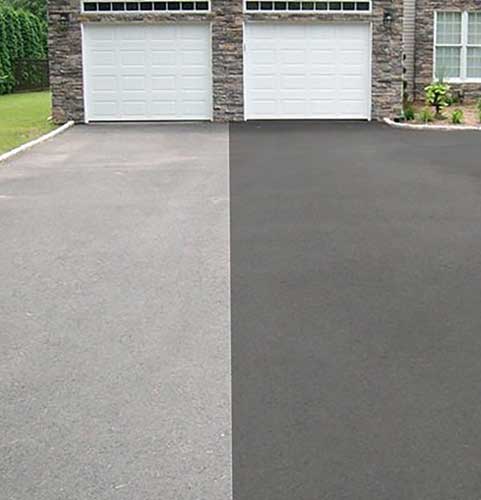Make Best Use Of Safety with Angle Parking Lot: Superior Asphalt Sealing
Cold Mix Asphalt Vs. Hot Mix Asphalt: Which Is Right for You?

Composition Distinctions
Cold mix and hot mix asphalts vary significantly in their make-up, with distinct attributes that influence their efficiency and applications. Cold mix asphalt is created by emulsifying the asphalt binder with water and an emulsifying agent prior to blending it with aggregate. This technique permits the asphalt to be practical at reduced temperatures, making it excellent for momentary fixings and for use in chillier weather condition conditions. Warm mix asphalt, on the various other hand, is made at heats, typically in between 300-350 ° F, which aids to attain far better compaction and an extra durable last product. The hot mix asphalt production process entails warming the accumulation and asphalt binder independently prior to combining them at the asphalt plant.
Furthermore, cold mix asphalt often tends to be less thick and more flexible than hot mix asphalt. This adaptability makes it much better fit for areas with higher degrees of activity, such as driveways or roads with heavy traffic. In contrast, hot mix asphalt is known for its high toughness and resistance to rutting and cracking, making it a favored selection for freeways and high-traffic roads where longevity is essential.
Installment Process Variations
The process of mounting cool mix and hot mix asphalt shows significant differences in their needs and procedures. In comparison, hot mix asphalt requires an extra elaborate setup process. Due to the home heating requirements, hot mix asphalt setups are commonly lugged out by professionals with specific devices, ensuring a more structurally sound and long-term result.
Sturdiness and Long Life Factors
When thinking about asphalt alternatives, longevity and durability are vital aspects to assess for lasting pavement efficiency. Hot mix asphalt (HMA) is recognized for its phenomenal resilience and longevity.
In regards to longevity, HMA commonly surpasses CMA due to its premium stamina and resistance homes. HMA pavements have a longer life span, requiring much less frequent fixings and maintenance, which can convert to set you back savings in the lengthy run. Additionally, HMA pavements are more quickly customizable to satisfy details job requirements, additionally enhancing their toughness.
Cost Factors To Consider
Taking into consideration the economic effects is an important facet when assessing the option between try this out hot mix asphalt (HMA) and chilly mix asphalt (CMA) for pavement tasks. While the preliminary price of hot mix asphalt is normally higher than that of cold mix asphalt, HMA usually provides a more cost-efficient remedy in the lengthy run due to its superior sturdiness and durability.
In addition to product prices, it's vital to take into consideration the expenditures related to installation and upkeep when comparing HMA and CMA. HMA usually calls for specific equipment and experienced labor for correct setup, which can impact total job costs. Conversely, CMA is less complicated to function with and can frequently be used using simpler strategies, potentially lowering setup costs. Eventually, the decision in between HMA and CMA should take into consideration not simply the preliminary cost yet also the lasting financial ramifications to establish the most cost-efficient choice for the certain pavement project.
Environmental Impact Contrast
Contrast of the ecological effects in between hot mix asphalt (HMA) and cold mix asphalt (CMA) discloses distinctive differences in sustainability techniques. HMA manufacturing calls for high temperature levels, leading to increased energy consumption and greenhouse gas emissions.
Furthermore, the use of CMA typically includes recycling existing asphalt sidewalk, advertising source preservation and reducing the amount of waste sent out to land fills. By opting for CMA over HMA, roadway building jobs can add favorably to environmental preservation initiatives.
Conclusion
To conclude, the option in between chilly mix asphalt (CMA) and hot mix asphalt (HMA) depends on numerous aspects such as make-up, installation procedure, resilience, long life, expense, and ecological influence. asphalt patch repair. While CMA supplies a cost-effective and quick solution for minor repair services, HMA ensures superior resilience and durability for heavy traffic areas. Take into consideration these aspects meticulously to figure out which sort of asphalt is the right choice for your paving requires

Thinking about the financial effects is an essential facet when reviewing the choice in between hot mix asphalt (HMA) and cold mix asphalt (CMA) for pavement projects. While the initial cost of hot mix asphalt is typically higher than that of cold mix asphalt, HMA usually click here for more offers a more affordable remedy in the long run due to its exceptional resilience and long life. cold mix asphalt.Contrast of the environmental effects in between hot mix asphalt (HMA) and chilly mix asphalt (CMA) reveals unique distinctions in sustainability techniques.In conclusion, the option in between cool mix asphalt (CMA) and warm mix asphalt (HMA) depends on different elements such as structure, installation procedure, longevity, long life, expense, her response and ecological effect